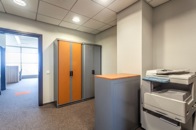 A printer is an integral piece of office equipment that often goes unnoticed until things go awry. Of course, this is because a malfunctioning printer can rapidly stifle productivity.
A printer is an integral piece of office equipment that often goes unnoticed until things go awry. Of course, this is because a malfunctioning printer can rapidly stifle productivity.
Most people don’t really think about the reasons why a printer breaks down or experiences errors. In many cases, the multifunction printer is put through quite a bit of abuse prior to the final malfunction. In this article I want to focus on the environmental factors that can create performance problems for printers. Thankfully, these problems are not hard to avoid; read on to learn how.
#1: Overall Cleanliness
One of the best ways to avoid print errors and malfunctions is to make sure your printer is kept in a clean environment. Printers should be stored in a low traffic area in order to avoid dust buildup and to control exposure to possible contaminants. Printers that are not kept in clean areas eventually experience issues, most commonly poor print quality production.
Of course, it’s not enough just to store your printer in a clean environment. You will also need to actively clean your printer. Here are a few tips to keep your printing environment and equipment clean:
- Avoid touching the printer glass with fingers
- Sweep or vacuum the area where you house your printer frequently
- Clean all printer surfaces with an electrostatic cloth on a regular basis
- Clean the incoming paper tray as needed
#2: Temperatures
Believe it or not, temperature and humidity levels play an important part in maintaining printer health. These factors can greatly impact printer functionality. Your printer should be performing all print-related tasks in a temperature range of 18 to 24°C (65 to 75°F) with relative humidity hovering between 40 to 60 percent. Printing in an environment that doesn’t adhere to these recommendations can lead to reduced print quality, feeding issues and jams.
Printer paper can also absorb moisture from the environment. This can cause paper to become wavy and curl, eventually leading to paper jams or other printing mishaps.
#3: Exposure to Contaminants
You can store your printer in a pristine environment with temperature controls and other precautions, but none of this will do you any good if users are bringing “contaminants” into the printing area. Your printer should not be exposed to dust, sticky fingers, food, post-it notes, paper clips and other related items. This might seem like common-sense, but you might be surprised at how often these actions cause issues.
This happens all too often in office environments when staff are trying to combine printing or copying with other tasks (grabbing a snack, a drink, etc.) or not removing attachments to documents (staples, post-it notes, tape, paper clips). It’s imperative that all printer users are aware of the consequences these types of contaminants will cause when exposed to the printer. Putting up signs is one effective way to remind staff not to unnecessarily expose the printer to food, beverages and other substances; communicating these guidelines is an easy way to avoid this issue.
Now that you know the environmental reasons behind printer malfunctions, you should be able to easily avoid them. Providing the proper care and environment for your printer can help you ensure that your printer will last longer and operate more efficiently.
For more tips and advice related to business technology, sign up to receive our newsletter.